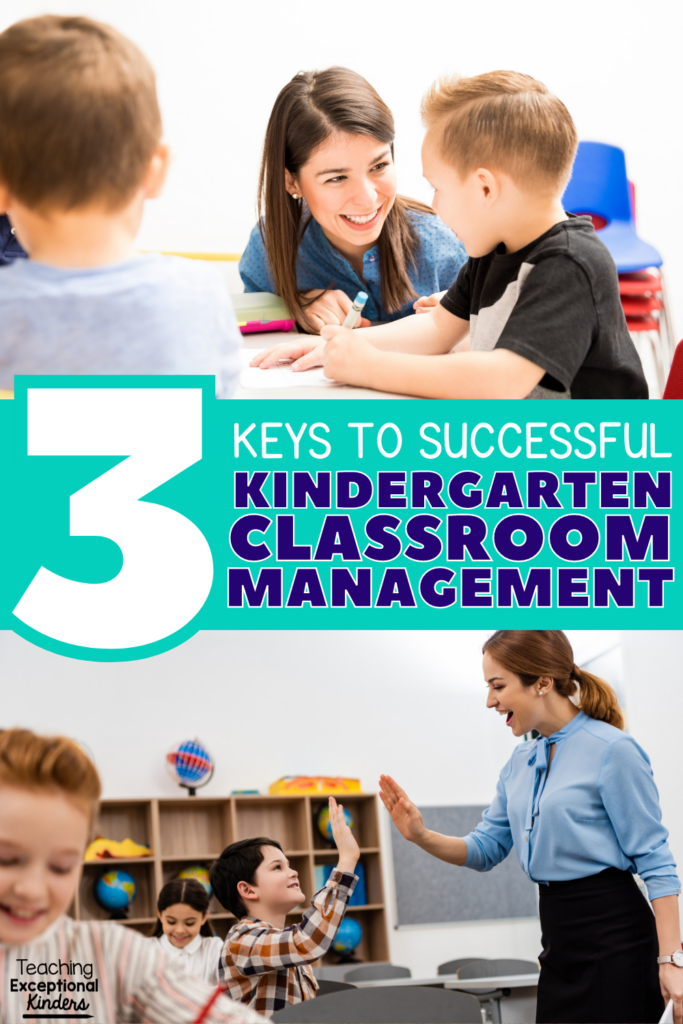3 Keys to Successful Classroom Management in Kindergarten
It can feel overwhelming to think about everything that needs to happen in a kindergarten classroom, especially at the beginning of the year. We all know that one of the most important things to do at the beginning of the school year is work on classroom rules and procedures. However, successful classroom management in kindergarten goes beyond that. Don’t worry…that doesn’t mean it’s more complicated! In fact, today I’m sharing just three keys to successful classroom management. These three simple things will make it so much easier for your classroom to run smoothly for the entire school year.

Why Kindergarten Classroom Management is Essential
Classroom management in kindergarten is different than any other elementary grade level. Many of the students walking through the door of your kindergarten classroom on the first day have never been in a school setting. They have to learn things like how to sit at the carpet, how to be part of a group, and even how to handle school supplies. With so many things for these five and six-year-olds to think about, it can be difficult for them to remember classroom procedures and keep their behavior on track. This is when effective classroom management comes in handy!
Students in kindergarten also have a huge amount of important academic skills to learn, so time is of the essence! In a well-managed kindergarten classroom, learning can truly be the main focus of the day since less time has to be spent on behavior correction and procedure reminders.
3 Keys to Successful Classroom Management in Kindergarten
During my years in the classroom, I noticed a pattern in the things that helped my classroom run more smoothly. In fact, I am able to sum it up with just three keys to successful classroom management.
1- Build Relationships
First and foremost, classroom management depends on relationships. It’s important to take the time at the beginning of the year to get to know your students as well as their parents and guardians. Creating an environment of trust and building rapport is the foundation that will support your classroom management for the entire school year.

I know there are a lot of things demanding your attention at the beginning of the year, but building relationships with your students should be near the top of your list. This doesn’t have to be over the top or complicated! Later in this post, you’ll find practical tips and resources that can help you in your efforts to build rapport with your students and communicate with families.
2 – Be Consistent
Consistency is the next key to successful classroom management. Once you have established behavior expectations for kindergarten students, it’s vital that you are consistent in expectations, rewards, and consequences. When there is a breakdown in consistency, young learners are much less likely to follow the classroom rules and expectations because it is essentially a moving target.

Consistency is also important in classroom routines. Kindergarten students thrive in environments with predictability in routines and procedures. This allows students to increase their independence because they are able to complete the procedures with minimal reminders from the teacher. This is especially true when classroom visuals are used along with consistent routines and procedures!
3- Be Prepared
Even when you take the time to build relationships and set up consistent procedures, there will inevitably be behaviors in the classroom that will need to be addressed. The final key to successful classroom management is to be prepared for these moments! It’s important that kindergarten behavior management is simple so that you can address behaviors quickly and effectively.
The first thing that you’ll want to prepare is your plan for addressing behaviors in the moment. How will you support students who are in a state of escalation? Where can they go to calm down? How will your response to the behavior foster your relationship and rapport with the student?

Once you have a plan in place for behavior management in the moment, you’ll also want to make a plan to ensure that behavior documentation takes place. This should include communicating with parents so that you can continue to foster those relationships. Again, you’ll want this to be simple so that you can easily take care of this in a timely manner. There are many reasons why behavior documentation is helpful in kindergarten, so have a plan that will make it easier for you!
Looking for more classroom management support?
I've designed the Kindergarten Behavior Blueprint to share all the tools and strategies I used to build the foundation for successful classroom in kindergarten. We are opening for new members soon – join our waitlist below!
Helpful Printables for Classroom Management in Kindergarten
I also have a large bundle of classroom management printables that you can use in your kindergarten classroom! This bundle also addresses the three keys to successful classroom management. You’ll find a variety of parent communication tools that will foster strong relationships. It includes many different visual supports that will help you be more consistent in your classroom routines and procedures. There are also many different behavior management reward systems that are simple enough to encourage consistency. Finally, you’ll find everything you need to communicate and document behaviors in the classroom.
Everything in this bundle can be easily prepped and filed away so it’s ready to use throughout the school year. If you’d like to see everything that’s included in this HUGE money-saving bundle, you can find it in the Teaching Exceptional Kinders shop or on Teachers Pay Teachers.

Save These Kindergarten Classroom Management Tips
Be sure to add this pin to your favorite teaching board on Pinterest. You’ll be able to come back to these tips and resources whenever you’re ready!

Amy
SITE DESIGN BY LAINE SUTHERLAND DESIGNS

